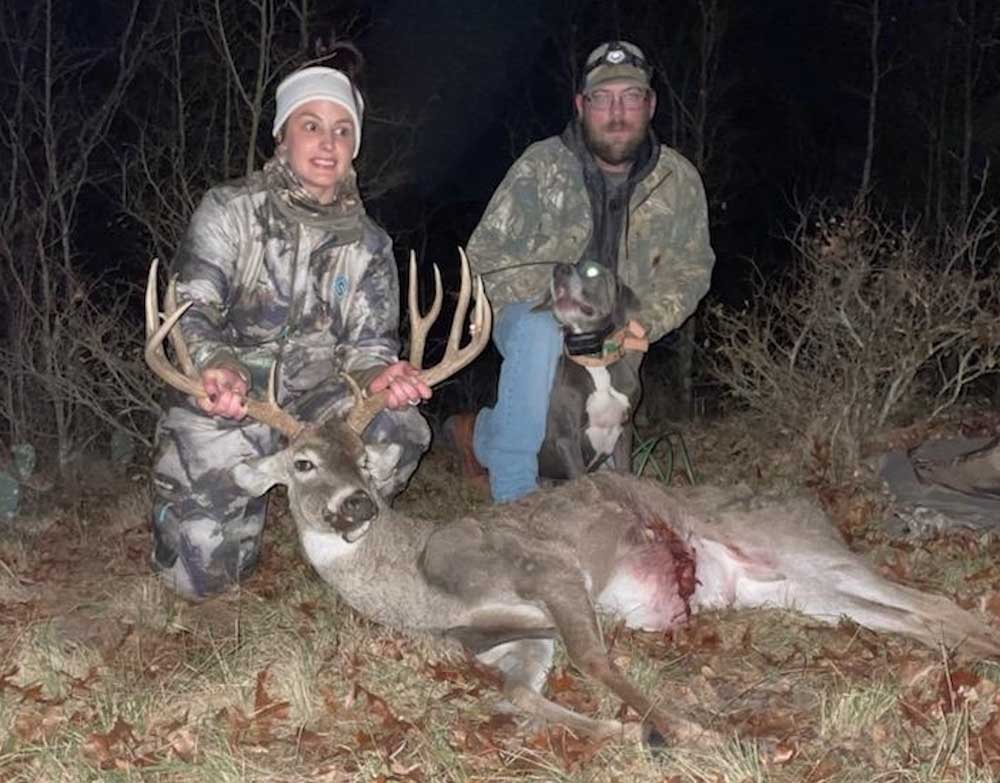Keeping Track: Deer Tracker Says Patience The Key In Recovering Game
Published 5:18 pm Thursday, September 23, 2021

- Thomas Yeakel and Moose have been tracking deer for hunters in the Hill Country for five years. Taking time to accurately recall a deer’s first movements after a shot is a key step to a successful search.
It does not matter whether you are using a bow or a rifle, buck fever is real and can impact any deer hunter’s shot.
If you are lucky after a misplaced shot, the deer runs 50 yards and falls dead in the edge of thick woods. Unlucky and it goes hundreds of yards, stopping several times on the way.
Either way there is an art to tracking a deer and the process starts the minute an arrow is released or trigger pulled. Professional tracker Thomas Yeakel of Mud Spring Lacy Dogs, of Burnet, suggests the first things hunters should do after a shot is wait before getting out of the blind. Take a minute to wind down and replay where the deer was standing, where the shot hit and exactly where it was last seen.
“It helps out quite a bit especially if they have videos that show where it hit,” said Yeakel.
Then he suggests wait a little more.
“Be more patient. Allow it to die and mark the blood trail with flags. A lot of time we are there at night and if they don’t leave flags we don’t know where to start,” Yeakel said
The next thing is to pull out a roll of flagging tape or a tracking app like onX or HuntStand to start a trail whether you make a quick recovery, have to back out and return later or call in a dog.
After getting a Blue Lacy dog almost a decade ago, Yeakel has become part of a growing fraternity around the state that hires out to track wounded deer for hunters.
“Last season I took just over 50 calls (to track). Last year was better than I have had in the past. I have usually 35 to 40 calls. Tracking dogs are getting more popular as more people know about them,” said Yeakel, whose regular job is as a ranch hand.
Yeakel originally got his first Lacy dog because the breed’s history. They are believed to be the only breed to have originated in Texas, earning it the designation as the official state dog. Working as a tracker was not on his radar, but after getting the dog and observing its desire to work he began to explore the idea.
He initially worked with hog hunters and then branched out searching for deer shot by family and friends. It was a multi-year process in part to get the dog organized with the process, but also for Yeakel to build up the confidence to let his dog work off-leash using a GPS tracker to keep up with its movements. Yeakel and Moose have now been tracking professionally for five years and he has three more young dogs in training.
Maybe it is because the majority of deer hunters in the Hill Country hunt with a rifle, but Yeakel said about 75 percent of his searches are assisting gun hunters.
“In my experience bow hunters are better hunters. They are getting shots at a closer range and usually they are a lot more patient,” he explained.
No matter their weapon of choice, Yeakel said it is surprising how many times a hunter gets confused with the excitement of the shot and is wrong about where the deer left the field and what trail it has taken. That is where the dog’s ability to follow a scent takes over.
“The dogs, their nose knows. Countless times the dog is on scent and the hunter tells me the deer didn’t go that way. Your dog is wrong. He is out there for a purpose,” Yeakel said.
Again with their excitement to claim their deer it is sometimes hard for hunters to know when to back out and wait. Yeakel recommends stopping when you come across the last quarter-sized drop of blood and cannot tell which trail to take. Whether you are going to call in other hunters or for a dog to help, that can be important so you don’t keep bumping a deer even farther.
It is also important if you are bringing in a dog so the scent doesn’t get disturbed and scattered.
Yeakel said a wounded deer might head for water or a familiar thicket, but there is not always rhyme or reason for its movement.
“I have tracked deer that will go uphill for 400 yards then hit a ridge and come back down and ended up 100 yards from shot. They are not thinking. They are in flight mode trying to get out of Dodge,” he said.
If a deer is not pushed by searching hunters or predators, it is typically found within 500 yards. With pressure, that distance can stretch to a mile if at all. The longer the trail, the more likely the wound clots and becomes harder to follow.
Not all of Yeakel’s retrieves are trophies based on size. On one occasion, his dog found a hunter’s first deer, a 141-inch buck. On another it was a buck for an 8-year-old that was tracked down on Christmas Day, 20 hours after it was shot. That buck ended up having 15 scoring points. The longest trailing was about a mile from where it had initially been shot.
“For me personally, it is more about the conservation end. Recovery of that animal and giving that animal what it is due. It is no good for the hunter or the animal not being recovered,” Yeakel said.
Yeakel works his dog within a two-hour radius of Burnet County. For more information, contact him at 512-234-1729.






